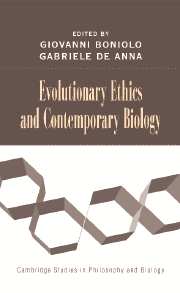Book contents
- Frontmatter
- Contents
- List of Contributors
- Evolutionary Ethics and Contemporary Biology
- Introduction
- PART I THE LIMITS OF EVOLUTIONARY EXPLANATIONS AND JUSTIFICATIONS OF ETHICS
- PART II METHODOLOGICAL ISSUES CONCERNING EVOLUTIONARY ACCOUNTS OF ETHICS
- PART III HOW BIOLOGICAL RESULTS CAN HELP EXPLAIN MORALLY RELEVANT HUMAN CAPACITIES
- 5 Genetic Influences on Moral Capacity: What Genetic Mutants Can Teach Us
- 6 Evolutionary Psychopharmacology, Mental Disorders, and Ethical Behavior
- 7 The Biology of Human Culture and Ethics: An Evolutionary Perspective
- PART IV HOW BIOLOGICAL RESULTS CAN HELP EXPLAIN MORAL SYSTEMS
- Index
- Cambridge Cultural Social Studies
- References
7 - The Biology of Human Culture and Ethics: An Evolutionary Perspective
Published online by Cambridge University Press: 23 July 2009
- Frontmatter
- Contents
- List of Contributors
- Evolutionary Ethics and Contemporary Biology
- Introduction
- PART I THE LIMITS OF EVOLUTIONARY EXPLANATIONS AND JUSTIFICATIONS OF ETHICS
- PART II METHODOLOGICAL ISSUES CONCERNING EVOLUTIONARY ACCOUNTS OF ETHICS
- PART III HOW BIOLOGICAL RESULTS CAN HELP EXPLAIN MORALLY RELEVANT HUMAN CAPACITIES
- 5 Genetic Influences on Moral Capacity: What Genetic Mutants Can Teach Us
- 6 Evolutionary Psychopharmacology, Mental Disorders, and Ethical Behavior
- 7 The Biology of Human Culture and Ethics: An Evolutionary Perspective
- PART IV HOW BIOLOGICAL RESULTS CAN HELP EXPLAIN MORAL SYSTEMS
- Index
- Cambridge Cultural Social Studies
- References
Summary
I searched for great human beings; I always found the apes of their ideals.
Nietzsche, Götzen-DämmerungThe human scientists proclaim that animals are irrelevant to the study of human beings and that there is no such thing as a universal human nature. The consequence is that science, so coldly successful at dissecting DNA, has proved spectacularly inept at tackling what the philosopher David Hume called the greater question of all: why is human nature what it is?
Ridley 1993The traditional nature-nurture controversy concerns whether ethical norms and social practices depend on cultural influences on individuals and societies or whether they are based on the particular features of our nature. In this chapter, we argue that nature and nurture cannot be sharply distinguished, as some scientists have tried to do in the past. Evolutionary considerations lead us to conclude that facts about our nature and the ways in which we come to form cultural traditions are entrenched in evolutionary processes. Before turning to the issue, though, we thought it might be worthwhile to deal first with two possible misunderstandings.
First, when we claim that we are concerned with the “bases” of ethical norms and practices, we do not mean that we offer a precise account of the ways in which such bases are relevant for the explanation or the justification of ethics. In particular, we do not deal with the question whether ethical systems or moral norms can be reduced to natural facts or cultural facts.
- Type
- Chapter
- Information
- Evolutionary Ethics and Contemporary Biology , pp. 121 - 138Publisher: Cambridge University PressPrint publication year: 2006
References
- 1
- Cited by



